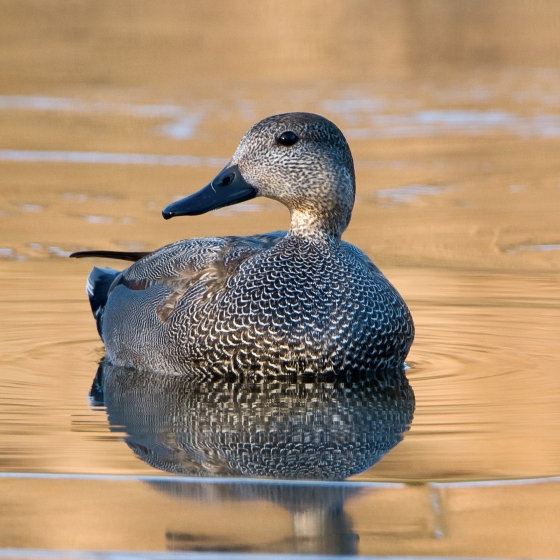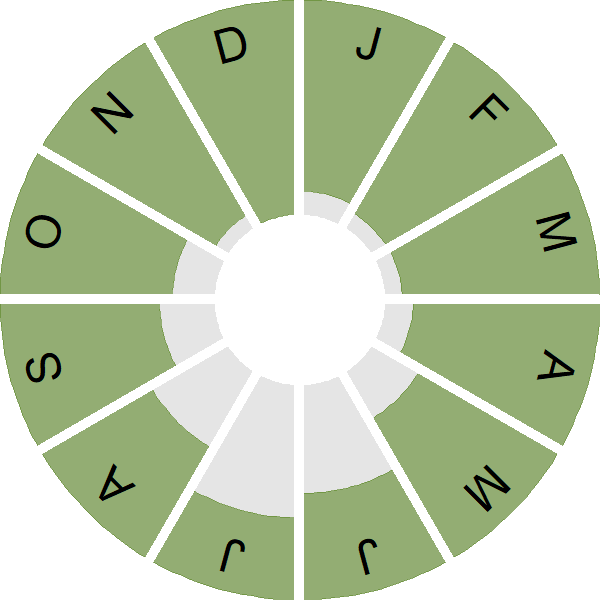Gadwall

Introduction
Slightly smaller than Mallard, Gadwall is a slimmer duck with a white speculum and (useful in flight) a whitish belly.
The Gadwall is a herbivorous surface-feeding duck that favours the more productive margins and shallower water of lakes and other waterbodies. It has been shown to exploit some deeper waterbodies thanks to a habit of stealing plant material collected by other waterbirds, including Coot.
As a breeding species, Gadwall is thought to have become established with the aid of introductions during the 1850s, since when the population has increased. Winter numbers are swelled through the arrival of individuals from both the Continent and Iceland.
- Our Trends Explorer gives you the latest insight into how this species' population is changing.

Key Stats
Identification
ID Videos
This section features BTO training videos headlining this species, or featuring it as a potential confusion species.
Female dabbling ducks
Songs and Calls
Call:
Flight call:
Status and Trends
Conservation Status
Population Change
Since wildfowlers released a wing-clipped pair of migrants in Norfolk in 1850, far from their native UK breeding distribution in Scotland, the breeding distribution of Gadwall has expanded and now covers much of lowland Britain, though with many gaps still in the west of the country (Balmer et al. 2013). Range expansion has been rapid since the 1950s. Numbers have recently surpassed the level where a BBS trend can be calculated: further strong increases are indicated and the population may even have redoubled over the latest 10-year period. Winter numbers, which include many continental visitors, have also risen strongly in England, Wales and Scotland, but show recent signs of levelling off in England (since around 2010/11) and have fluctuated in Northern Ireland (WeBS: Frost et al. 2020).
Distribution
The winter distribution of Gadwall is wider than in the breeding season due to dispersal from natal areas and the arrival of migrants from Iceland, the Netherlands, Scandinavia and central Europe. This is particularly evident in southwest England, coastal Wales and Ireland, and Shetland.
Occupied 10-km squares in UK
2007/08–10/11
or view it on Bird Atlas Mapstore.
2008–11
or view it on Bird Atlas Mapstore.
European Distribution Map
Distribution Change
From the former strongholds in East Anglia, Fife and Lough Neagh recorded during the 1968–72 Breeding Atlas, the breeding range of Gadwall has expanded throughout much of the lowlands of central, eastern and northwest England, eastern Scotland, Orkney and the Uists.
Change in occupied 10-km squares in the UK
from 1981–84 to 2007–11
or view it on Bird Atlas Mapstore.
from 1968–72 to 2008–11
or view it on Bird Atlas Mapstore.
Seasonality
Gadwalls are present year-round, recorded on up to 10% of complete lists in winter.
Weekly pattern of occurrence
The graph shows when the species is present in the UK, with taller bars indicating a higher likelihood of encountering the species in appropriate regions and habitats.

Movement
Britain & Ireland movement
Foreign locations of birds ringed or recovered in Britain & Ireland
Dots show the foreign destinations of birds ringed in Britain & Ireland, and the origins of birds ringed overseas that were subsequently recaptured, resighted or found dead in Britain & Ireland. Dot colours indicate the time of year that the species was present at the location.
- Winter (Nov-Feb)
- Spring (Mar-Apr)
- Summer (May-Jul)
- Autumn (Aug-Oct)

European movements
EuroBirdPortal uses birdwatcher's records, such as those logged in BirdTrack to map the flows of birds as they arrive and depart Europe. See maps for this species here.
The Eurasian-African Migration Atlas shows movements of individual birds ringed or recovered in Europe. See maps for this species here.
Biology
Productivity and Nesting
Nesting timing
Egg measurements
Clutch Size
Survival and Longevity
Survival is shown as the proportion of birds surviving from one year to the next and is derived from bird ringing data. It can also be used to estimate how long birds typically live.
View number ringed each year in the Online Ringing Report.
Lifespan
Survival of adults
Biometrics
Wing length and body weights are from live birds (source).
Wing length
Body weight
Ring Size
Classification, names and codes
Classification and Codes
- Order: Anseriformes
- Family: Anatidae
- Scientific name: Mareca strepera
- Authority: Linnaeus, 1758
- BTO 2-letter code: GA
- BTO 5-letter code: GADWA
- Euring code number: 1820
Alternate species names
- Catalan: ànec griset
- Czech: koprivka obecná
- Danish: Knarand
- Dutch: Krakeend
- Estonian: rääkspart
- Finnish: harmaasorsa
- French: Canard chipeau
- Gaelic: Lach-ghlas
- German: Schnatterente
- Hungarian: kendermagos réce
- Icelandic: Gargönd
- Irish: Gadual
- Italian: Canapiglia
- Latvian: peleka pile
- Lithuanian: pilkoji antis
- Norwegian: Snadderand
- Polish: krakwa
- Portuguese: frisada
- Slovak: kacica chriplavka
- Slovenian: konopnica
- Spanish: Ánade friso
- Swedish: snatterand
- Welsh: Hwyaden Lwyd
- English folkname(s): Grey Duck
Research
Causes of Change and Solutions
Causes of change
There is little good evidence available regarding the drivers of the breeding population increase in this species in the UK.
Further information on causes of change
No further information is available.
Information about conservation actions
Many of the current breeding populations probably descended from released birds, although the species is a native breeder in Scotland and it is unclear whether any of the introduced breeding populations have been joined by wild birds. As an increasing species, no specific conservation actions are currently required for Gadwall, although actions to maintain and create wetland habitats and to provide nesting sites for other wildfowl are also likely to support this species.
More Evidence
More evidence from Conservation Evidence.com
Partners
Citing BirdFacts
If you wish to cite particular content in this page (e.g. a specific value) it is best to use the original sources as linked in the page. For a more general citation of the whole page please use: BTO (20XX) BirdFacts Species: profiles of birds occurring in the United Kingdom. BTO, Thetford (www.bto.org/birdfacts, accessed on xx/xx/xxxx).

